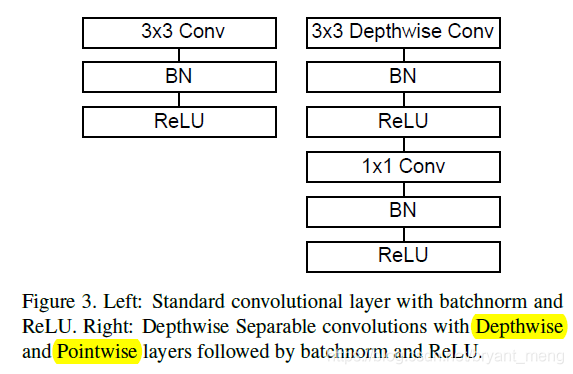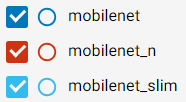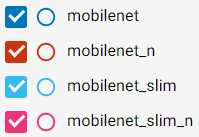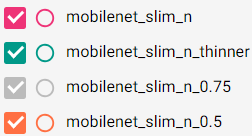系列连载目录
- 请查看博客 《Paper》 4.1 小节 【Keras】Classification in CIFAR-10 系列连载
学习借鉴
- github:BIGBALLON/cifar-10-cnn
- 知乎专栏:写给妹子的深度学习教程
- Mobilenet Caffe 代码:https://github.com/shicai/MobileNet-Caffe/blob/master/mobilenet_deploy.prototxt
- Mobilenet Keras 代码:https://github.com/Hedlen/Mobilenet-Keras/blob/master/model/mobilenet.py
参考
代码下载
- 链接:https://pan.baidu.com/s/1UYbkq56IVBB-fHHlG7p3yg
提取码:lpjd
硬件
- TITAN XP
文章目录
1 理论基础
参考【MobileNet】《MobileNets: Efficient Convolutional Neural Networks for Mobile Vision Applications》
精度相当,参数量更少,计算量更少,速度更快
2 Mobilenet 代码实现
2.1 mobilenet
1)导入库,设置好超参数
import os
os.environ["CUDA_DEVICE_ORDER"]="PCI_BUS_ID"
os.environ["CUDA_VISIBLE_DEVICES"]="0"
import keras
from keras.datasets import cifar10
from keras import backend as K
from keras.layers import Input, Conv2D,GlobalAveragePooling2D, Dense, BatchNormalization, Activation
from keras.models import Model
from keras.layers import DepthwiseConv2D
from keras import optimizers,regularizers
from keras.preprocessing.image import ImageDataGenerator
from keras.initializers import he_normal
from keras.callbacks import LearningRateScheduler, TensorBoard, ModelCheckpoint
num_classes = 10
batch_size = 64 # 64 or 32 or other
epochs = 300
iterations = 782
USE_BN=True
DROPOUT=0.2 # keep 80%
CONCAT_AXIS=3
weight_decay=1e-4
DATA_FORMAT='channels_last' # Theano:'channels_first' Tensorflow:'channels_last'
log_filepath = './mobilenet'
2)数据预处理并设置 learning schedule
def color_preprocessing(x_train,x_test):
x_train = x_train.astype('float32')
x_test = x_test.astype('float32')
mean = [125.307, 122.95, 113.865]
std = [62.9932, 62.0887, 66.7048]
for i in range(3):
x_train[:,:,:,i] = (x_train[:,:,:,i] - mean[i]) / std[i]
x_test[:,:,:,i] = (x_test[:,:,:,i] - mean[i]) / std[i]
return x_train, x_test
def scheduler(epoch):
if epoch < 100:
return 0.01
if epoch < 200:
return 0.001
return 0.0001
# load data
(x_train, y_train), (x_test, y_test) = cifar10.load_data()
y_train = keras.utils.to_categorical(y_train, num_classes)
y_test = keras.utils.to_categorical(y_test, num_classes)
x_train, x_test = color_preprocessing(x_train, x_test)
3)定义网络结构
depth-wise separable convolution
keras官方文档:https://keras.io/layers/convolutional/#depthwiseconv2d

def depthwise_separable(x,params):
# f1/f2 filter size, s1 stride of conv
(s1,f2) = params
x = DepthwiseConv2D((3,3),strides=(s1[0],s1[0]), padding='same')(x)
x = BatchNormalization()(x)
x = Activation('relu')(x)
x = Conv2D(int(f2[0]), (1,1), strides=(1,1), padding='same')(x)
x = BatchNormalization()(x)
x = Activation('relu')(x)
return x
- s1 控制 depth-wise convolution 的 stride,虽然 channels 固定,同输入一样,但是可以通过步长来改变输入的 resolution.
- f2 表示 point-wise convolution 的 filters 数量,也即输出的 channels
4)搭建网络
用 3)中设计好的模块来搭建网络,整体 architecture 如下:

括号表示 depth-wise separable convolution = depth-wise convolution + point-wise convolution
Down sampling ( ) is handled with strided convolution in the depthwise convolutions as well as in the first layer.
def MobileNet(img_input,shallow=False, classes=10):
"""Instantiates the MobileNet.Network has two hyper-parameters
which are the width of network (controlled by alpha)
and input size.
# Arguments
alpha: optional parameter of the network to change the
width of model.
shallow: optional parameter for making network smaller.
classes: optional number of classes to classify images
into.
"""
x = Conv2D(int(32), (3,3), strides=(2,2), padding='same')(img_input)
x = BatchNormalization()(x)
x = Activation('relu')(x)
x = depthwise_separable(x,params=[(1,),(64,)])
x = depthwise_separable(x,params=[(2,),(128,)])
x = depthwise_separable(x,params=[(1,),(128,)])
x = depthwise_separable(x,params=[(2,),(256,)])
x = depthwise_separable(x,params=[(1,),(256,)])
x = depthwise_separable(x,params=[(2,),(512,)])
if not shallow:
for _ in range(5):
x = depthwise_separable(x,params=[(1,),(512,)])
x = depthwise_separable(x,params=[(2,),(1024,)])
x = depthwise_separable(x,params=[(1,),(1024,)])
x = GlobalAveragePooling2D()(x)
out = Dense(classes, activation='softmax')(x)
return out
5)生成模型
img_input=Input(shape=(32,32,3))
output = MobileNet(img_input)
model=Model(img_input,output)
model.summary()
Total params: 3,250,058
Trainable params: 3,228,170
Non-trainable params: 21,888
6)开始训练
# set optimizer
sgd = optimizers.SGD(lr=.1, momentum=0.9, nesterov=True)
model.compile(loss='categorical_crossentropy', optimizer=sgd, metrics=['accuracy'])
# set callback
tb_cb = TensorBoard(log_dir=log_filepath, histogram_freq=0)
change_lr = LearningRateScheduler(scheduler)
cbks = [change_lr,tb_cb]
# set data augmentation
datagen = ImageDataGenerator(horizontal_flip=True,
width_shift_range=0.125,
height_shift_range=0.125,
fill_mode='constant',cval=0.)
datagen.fit(x_train)
# start training
model.fit_generator(datagen.flow(x_train, y_train,batch_size=batch_size),
steps_per_epoch=iterations,
epochs=epochs,
callbacks=cbks,
validation_data=(x_test, y_test))
model.save('mobilenet.h5')
7)结果分析
training accuracy 和 training loss



- accuracy

- loss

97% +
test accuracy 和 test loss



…………
精度很低,80%+,耐克出现,过拟合严重。很好理解,在 imagenet 上,输入224,最后一次 convolution 的 resolution 为 7×7,down sampling 了5次(
),CIFAR-10 输入32,down sampling 4 次之后,convolution 的作用就很有限了。
2.2 mobilenet_n
2.1 明显过拟合
- 我们在 point-wise 里加正则化策略,为啥不在 depth-wise convolution 中也加入 l2 regularization + weight decay 策略呢?因为论文中有一句是这么说的:put very little or no weight decay (l2 regularization) on the depthwise filters since their are so few parameters in them,我们暂时只改 point-wise convolution 部分;
- 改变 depth-wise 和 point-wise convolution 的初始化策略,默认
glorot_uniform,我们用he_normal
代码修改部分如下
def depthwise_separable(x,params):
# f1/f2 filter size, s1 stride of conv
(s1,f2) = params
x = DepthwiseConv2D((3,3),strides=(s1[0],s1[0]), padding='same',depthwise_initializer="he_normal")(x)
x = BatchNormalization(momentum=0.9, epsilon=1e-5)(x)
x = Activation('relu')(x)
x = Conv2D(int(f2[0]), (1,1), strides=(1,1), padding='same',
kernel_initializer="he_normal",kernel_regularizer=regularizers.l2(weight_decay))(x)
x = BatchNormalization(momentum=0.9, epsilon=1e-5)(x)
x = Activation('relu')(x)
return x
其它部分代码同 mobilenet
参数量如下(不变):
Total params: 3,250,058
Trainable params: 3,228,170
Non-trainable params: 21,888
- mobilenet
Total params: 3,250,058
结果分析如下:
training accuracy 和 training loss



test accuracy 和 test loss



…………
精度提升了,84%+,还是耐克出现,过拟合严重。还是那样理解,在 imagenet 上,输入224,最后一次 convolution 的 resolution 为 7×7,down sampling 了5次(
),CIFAR-10 输入32,down sampling 4 次之后,convolution 的作用就很有限了。
2.3 mobilenet_slim
在2.2小节的基础上,类似 【Keras-Inception-resnet v1】CIFAR-10、【Keras-Inception-resnet v2】CIFAR-10,我们把前三个 down sampling 取消,也即前三个stride=2 改为 stride =1,保证 feature map 的 resolution.
代码修改部分如下:
def MobileNet(img_input,shallow=False, classes=10):
"""Instantiates the MobileNet.Network has two hyper-parameters
which are the width of network (controlled by alpha)
and input size.
# Arguments
alpha: optional parameter of the network to change the
width of model.
shallow: optional parameter for making network smaller.
classes: optional number of classes to classify images
into.
"""
# change stride
x = Conv2D(int(32), (3,3), strides=(1,1), padding='same',
kernel_initializer="he_normal",kernel_regularizer=regularizers.l2(weight_decay))(img_input) # change stride
x = BatchNormalization()(x)
x = Activation('relu')(x)
x = depthwise_separable(x,params=[(1,),(64,)])
x = depthwise_separable(x,params=[(1,),(128,)])# change stride
x = depthwise_separable(x,params=[(1,),(128,)])
x = depthwise_separable(x,params=[(1,),(256,)])# change stride
x = depthwise_separable(x,params=[(1,),(256,)])
x = depthwise_separable(x,params=[(2,),(512,)])
if not shallow:
for _ in range(5):
x = depthwise_separable(x,params=[(1,),(512,)])
x = depthwise_separable(x,params=[(2,),(1024,)])
x = depthwise_separable(x,params=[(1,),(1024,)])
x = GlobalAveragePooling2D()(x)
out = Dense(classes, activation='softmax')(x)
return out
其它部分代码同:mobilenet_n
参数量如下(不变):
Total params: 3,250,058
Trainable params: 3,228,170
Non-trainable params: 21,888
- mobilenet
Total params: 3,250,058 - mobilenet_n
Total params: 3,250,058
结果分析如下:
training accuracy 和 training loss



到 99.9%了,好兆头!训练时间增加了很多,很好理解,因为 resolution 提高了,计算量自然提高了
test accuracy 和 test loss



…………

精度92%+,缓解了过拟合
2.4 mobilenet_slim_n
在2.3的基础上,尝试对 depth-wise convolution 来一下 l2 regularization + weight decay
论文中说了 put very little or no weight decay (l2 regularization) on the depthwise filters since their are so few parameters in them
代码修改部分如下
def depthwise_separable(x,params):
# f1/f2 filter size, s1 stride of conv
(s1,f2) = params
x = DepthwiseConv2D((3,3),strides=(s1[0],s1[0]), padding='same',
depthwise_initializer="he_normal",depthwise_regularizer=regularizers.l2(weight_decay))(x)
x = BatchNormalization(momentum=0.9, epsilon=1e-5)(x)
x = Activation('relu')(x)
x = Conv2D(int(f2[0]), (1,1), strides=(1,1), padding='same',
kernel_initializer="he_normal",kernel_regularizer=regularizers.l2(weight_decay))(x)
x = BatchNormalization(momentum=0.9, epsilon=1e-5)(x)
x = Activation('relu')(x)
return x
其它部分的代码同mobilenet_slim
参数量如下(不变):
Total params: 3,250,058
Trainable params: 3,228,170
Non-trainable params: 21,888
- mobilenet
Total params: 3,250,058 - mobilenet_n
Total params: 3,250,058 - mobilenet_slim
Total params: 3,250,058
结果分析如下:
training accuracy 和 training loss



和 mobilenet_slim 差不多
test accuracy 和 test loss



…………
精度突破93%,略胜一筹
2.5 mobilenet_slim_n_thinner
在 2.4 小节的基础上,我们把下表中,红色框框部分去掉,也即 5x 的结构

代码修改部分如下:
可以删掉相应结构的代码,也可以直接把函数定义部分的形参 shallow=True 从 False 改为 True
def MobileNet(img_input,shallow=True, classes=10):
"""Instantiates the MobileNet.Network has two hyper-parameters
which are the width of network (controlled by alpha)
and input size.
# Arguments
alpha: optional parameter of the network to change the
width of model.
shallow: optional parameter for making network smaller.
classes: optional number of classes to classify images
into.
"""
# change stride
x = Conv2D(int(32), (3,3), strides=(1,1), padding='same',
kernel_initializer="he_normal",kernel_regularizer=regularizers.l2(weight_decay))(img_input)
x = BatchNormalization()(x)
x = Activation('relu')(x)
x = depthwise_separable(x,params=[(1,),(64,)])
x = depthwise_separable(x,params=[(1,),(128,)])# change stride
x = depthwise_separable(x,params=[(1,),(128,)])
x = depthwise_separable(x,params=[(1,),(256,)])# change stride
x = depthwise_separable(x,params=[(1,),(256,)])
x = depthwise_separable(x,params=[(2,),(512,)])
if not shallow:
for _ in range(5):
x = depthwise_separable(x,params=[(1,),(512,)])
x = depthwise_separable(x,params=[(2,),(1024,)])
x = depthwise_separable(x,params=[(1,),(1024,)])
x = GlobalAveragePooling2D()(x)
out = Dense(classes, activation='softmax')(x)
return out
其它部分代码同 mobilenet_slim_n
参数量如下(减少):
Total params: 1,890,698
Trainable params: 1,879,050
Non-trainable params: 11,648
- mobilenet
Total params: 3,250,058 - mobilenet_n
Total params: 3,250,058 - mobilenet_slim
Total params: 3,250,058 - mobilenet_slim_n
Total params: 3,250,058
结果分析如下:
test accuracy 和 test loss

速度大幅度提升,精度有所牺牲
2.6 mobilenet_slim_n_0.75 / 0.5
在 2.4 小节的基础上,加入论文中 width multiplier 的 hyper parameters,也即
修改代码部分如下:
- 设置 超参数(0.75 或者 0.5)
alpha = 0.75
- 修改 depth-wise separable convolution
def depthwise_separable(x,params):
# f1/f2 filter size, s1 stride of conv
(s1,f2) = params
x = DepthwiseConv2D((3,3),strides=(s1[0],s1[0]), padding='same',
depthwise_initializer="he_normal",depthwise_regularizer=regularizers.l2(weight_decay))(x)
x = BatchNormalization(momentum=0.9, epsilon=1e-5)(x)
x = Activation('relu')(x)
x = Conv2D(int(alpha*f2[0]), (1,1), strides=(1,1), padding='same',
kernel_initializer="he_normal",kernel_regularizer=regularizers.l2(weight_decay))(x)
x = BatchNormalization(momentum=0.9, epsilon=1e-5)(x)
x = Activation('relu')(x)
return x
- 修改网络结构的第一个卷积
x = Conv2D(int(alpha*32), (3,3), strides=(1,1), padding='same',
kernel_initializer="he_normal",kernel_regularizer=regularizers.l2(weight_decay))(img_input)
其它部分代码同 mobilenet_slim_n
参数量如下(减少,和 mobilnet_slim_n_thinner 的参数量相仿):
- mobilenet
Total params: 3,250,058 - mobilenet_n
Total params: 3,250,058 - mobilenet_slim
Total params: 3,250,058 - mobilenet_slim_n
Total params: 3,250,058 - mobilnet_slim_n_thinner
Total params: 1,890,698 - mobilnet_slim_n_0.75
Total params: 1,848,874 - mobilnet_slim_n_0.5
Total params: 840,138
结果分析如下:
test accuracy 和 test loss



可以看到,0.5 和 thinner 精度和速度相仿,这一小节也算是 trade-off latent 和 accuracy 吧!
论文中,对比了 0.75 Mobilenet 与 Shallow Mobilenet(也就是我们这里的2.5小节) 在 ImageNet 上的表现

3 总结
精度最高的是 mobilenet_slim_n
模型大小

参数量
- mobilenet
Total params: 3,250,058 - mobilenet_n
Total params: 3,250,058 - mobilenet_slim
Total params: 3,250,058 - mobilenet_slim_n
Total params: 3,250,058 - mobilnet_slim_n_thinner
Total params: 1,890,698 - mobilnet_slim_n_0.75
Total params: 1,848,874 - mobilnet_slim_n_0.5
Total params: 840,138